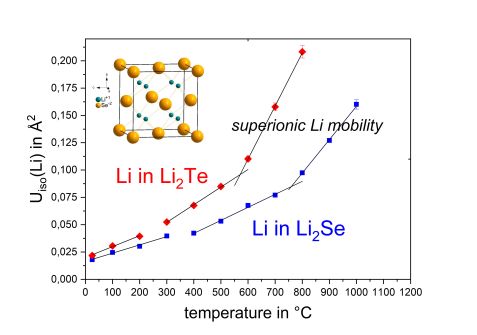MLZ is a cooperation between:
 > Technische Universität München
> Technische Universität München > Helmholtz-Zentrum Hereon
> Helmholtz-Zentrum Hereon
 > Forschungszentrum Jülich
> Forschungszentrum Jülich
MLZ is a member of:
 > LENS
> LENS > ERF-AISBL
> ERF-AISBL
MLZ on social media:

MLZ (eng)
Lichtenbergstr.1
85748 Garching
28.10.2019
A prize winning publication

Dr. Markus Hölzel (r.), scientist at SPODI and Dr. Julius Schneider of Ludwig-Maximilians-University Munich at the research neutron source Heinz Maier-Leibnitz (FRM II) of the Technical University of Munich. © Wenzel Schürmann/ TUM
It is a sunny July evening in Munich, no cloud is up in the sky. While the sun slowly descends over the city, the people of Munich let the day fade away in a relaxed atmosphere at the Hofgarten. Dr. Julius Schneider, Dr. Markus Hölzel, Dr. Thorsten Schröder, Prof. Dr. Wolfgang Schmahl and Prof. Dr. Oliver Oeckler have settled among them. They have a special reason to be happy: “We would like to celebrate this extraordinary prize in a Munich way,” explains Julius Schneider with a smile.
He is the lead author of the paper “Phase transitions to superionic Li2Te and Li2Se – a high temperature neutron powder diffraction study, atom displacements, probability density functions and atom potentials”, in which the other four scientists and another colleague from the Ludwig Maximilian Universität München, the University of Leipzig and the Technical University of Munich collaborated. The professional magazine “Solid State Ionics” has now named it the best publication of 2018. The award is accompanied by a prize money of three thousand US dollars.
Why has this work been awarded? “This is perhaps due to the detailed way in which the data analysis is described,” says Markus Hölzel. He is the scientist at the powder diffractometer SPODI at the Heinz Maier-Leibnitz Center, where the measurements were carried out. “It seems to have been very well received that we have gone into our method in such detail. We initially described the measured data without a model. From this we determined profile parameters for the next fit, where we adopted a very rudimentary model. Bit by bit, we expanded the model by incorporating newly acquired parameters. We described each step very precisely and finally compared different models in detail,” Julius Schneider and Markus Hölzel continue to explain in turn. “I think the committee liked the didactic structure very much.”

Superionic behaviour of lithium selenide and lithium telluride starting at approx. 780 °C and 600 °C respectively. © M. Hölzel, FRM II/TUM
But what is the work about? Lithium selenide and lithium telluride are subjects of current research in the search for new battery materials with high energy density. The crystal structures of these materials consist of a grid of positively charged particles (lithium cations) and negatively charged particles (selenium or tellurium anions).
The lithium ions can transport charge in the crystal with the help of ion flow. Lithium selenide (Li2Se) and lithium telluride (Li2Te) show superionic behavior at high temperatures. Julius Schneider and his colleagues investigated the corresponding structural changes by neutron diffraction on the instrument SPODI using powder samples of lithium selenide (Li2Se) and lithium telluride (Li2Te). Neutron diffraction was used to locate the lithium ions and to elucidate the thermal oscillations of the atoms. The superionic behavior only starts at very high temperatures (from approx. 600°C at Li2Te and approx. 780°C at Li2Se). From these temperatures, the thermal movement of lithium increases very quickly, allowing it to leave its position in the crystal lattice, as the measurements on the SPODI instrument have shown. The lattice of the large, heavy anions remains in its structure, which is why the substance is also preserved as a solid. “Our primary concern was to understand the ionic conductivity and the transition to superionic behavior. This is important to be able to find and apply related systems with corresponding superionic transitions at lower temperatures or even room temperature,” says Julius Schneider. “But who knows if we will need batteries for extreme conditions at some point,” he adds with a laugh.
Slowly the sun disappears behind the roofs of the houses. “We were very pleased with the award,” says Julius Schneider with a satisfied smile. “I think of how many times we have revised the manuscript. We are all glad that it was so well received in the end.”
Original publication:
J. Schneider, T. Schröder, M. Hölzel, O. Kluge, W. Schmahl, O. Oeckler
Solid State Ionics 325, 90 (2018)
DOI: 10.1016/j.ssi.2018.07.024
MLZ is a cooperation between:
 > Technische Universität München
> Technische Universität München > Helmholtz-Zentrum Hereon
> Helmholtz-Zentrum Hereon
 > Forschungszentrum Jülich
> Forschungszentrum Jülich
MLZ is a member of:
 > LENS
> LENS > ERF-AISBL
> ERF-AISBL
MLZ on social media:


